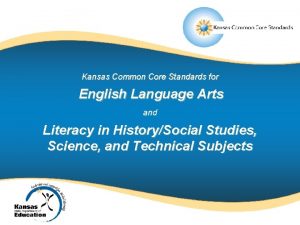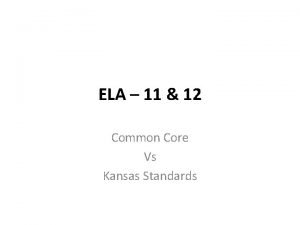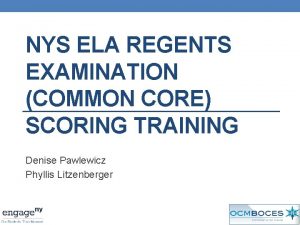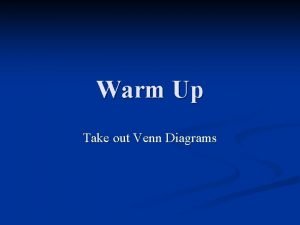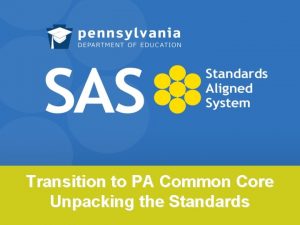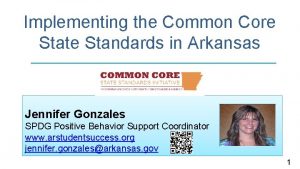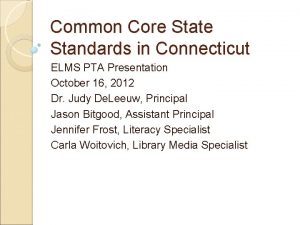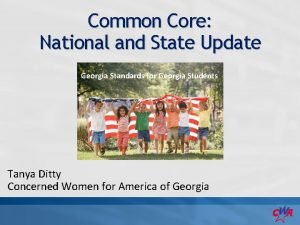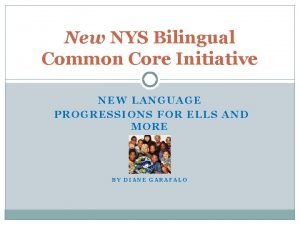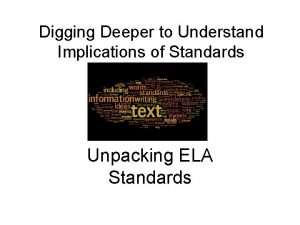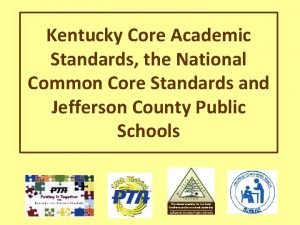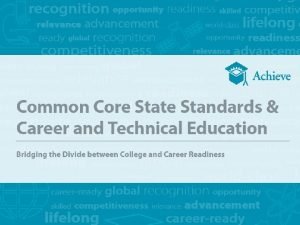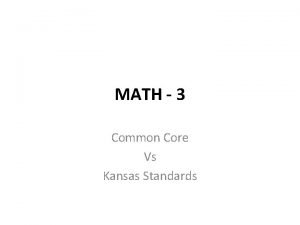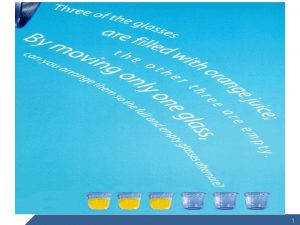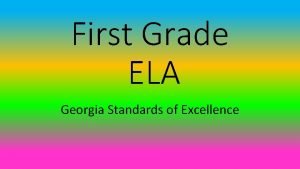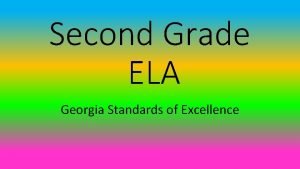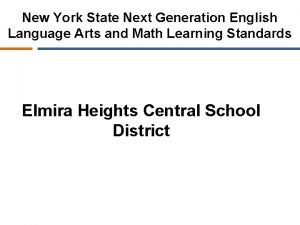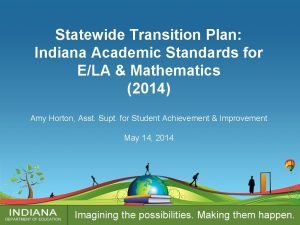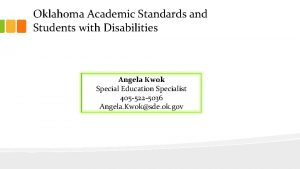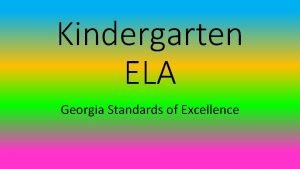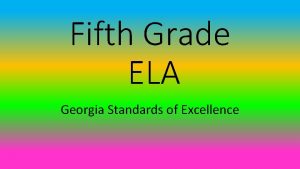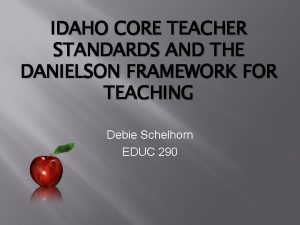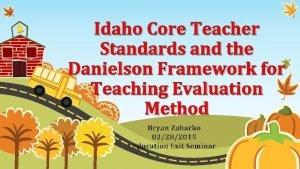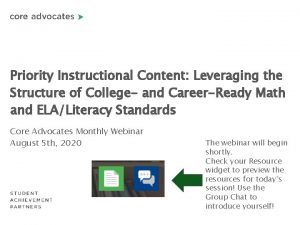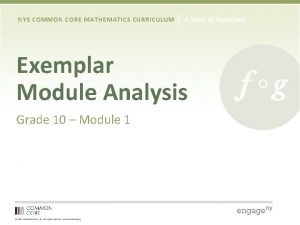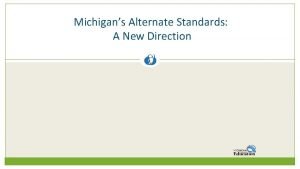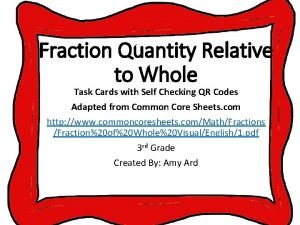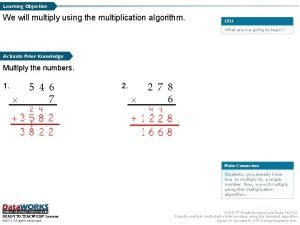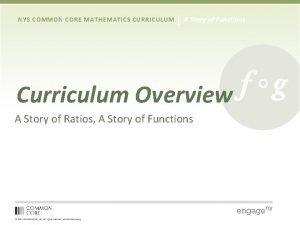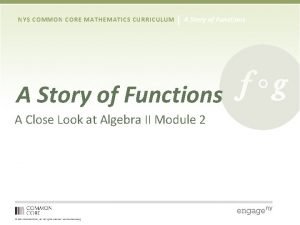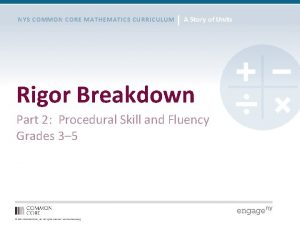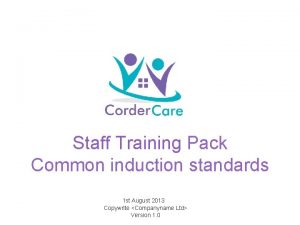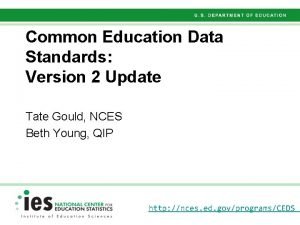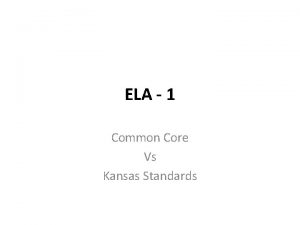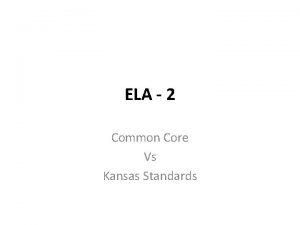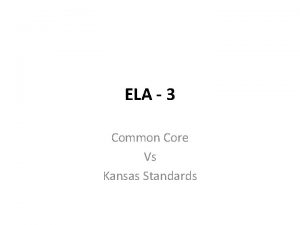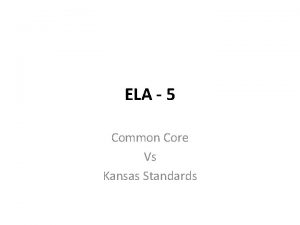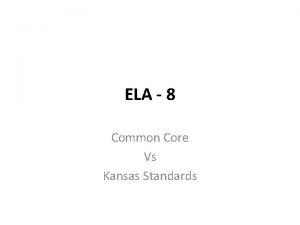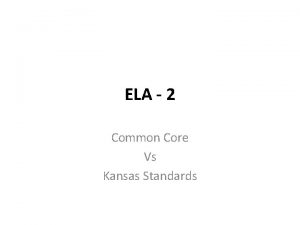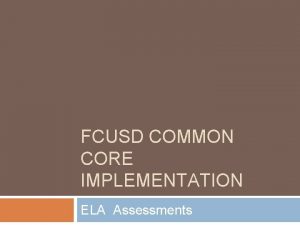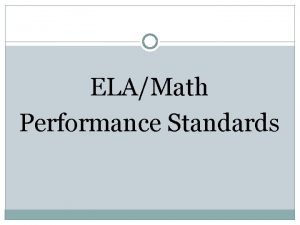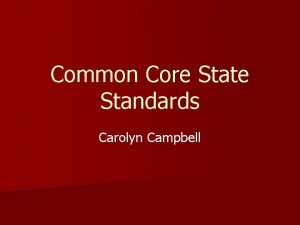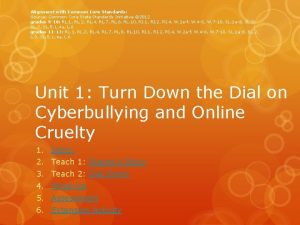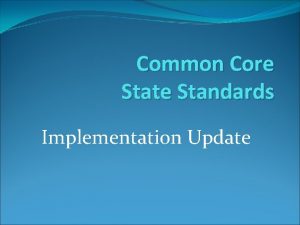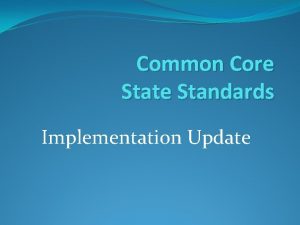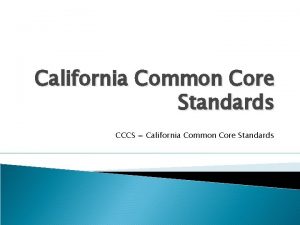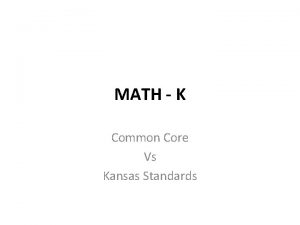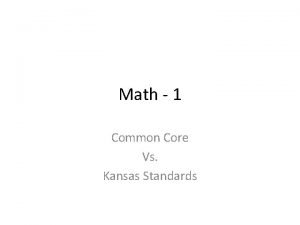ELA 9 10 Common Core Vs Kansas Standards













































- Slides: 45

ELA – 9 & 10 Common Core Vs Kansas Standards

DOMAIN Standards For Literature (RL)

Cluster: Key Ideas and Details Common Core Same 9 -10 RL. 1 Cite strong and thorough textual evidence to support analysis of what the text says explicitly as well as inferences drawn from the text. 9 -10 RL. 2 Determine theme or central idea of text and analyze it using specific detail 9 -10 RL. 3 Analyzing complex characters and how they change over the course of a text, how they interact with other characters, and develop the plot or theme. Old Kansas Standard

p. 2 Removed Moved to another Grade ( )

Cluster: Craft and Structure New in Common Core Same 9 -10 RL. 4 Determine the meaning of words and phrases as they are used in text, including figurative and connotative meanings, and how word choice impacts meaning and tone. 9 -10 RL. 5 Analyze how author’s choices of language and text structure (flashbacks, frame story) create certain effects in the story. 9 -10 RL. 6 *Emphasis on literature from outside the US, drawing on wide variety of world lit 9 -10 RL. 6 Analyze how a particular point of view or cultural experience influences how a character acts or feels in a literary text. Old Kansas Standard

p. 2 Removed Moved to another Grade ( )

Cluster: Integration of Knowledge and Ideas New in Common Core Same 9 -10 RL. 7 *Compare and contrast varying elements in two different artistic mediums- what’s absent/emphasized 9 -10 RL. 7 Compare and contrast varying elements 9 -10 RL. 9 Analyzes how an author draws on and transforms source material in a specific work (allusion) Old Kansas Standard

p. 2 Removed Moved to another Grade ( )

Cluster: Range of Reading and level of Text Complexity New in Common Core 9 -10 RL. 10 By the end of grade 9, proficiently read and comprehend varying literature (short stories, dramas, poems, etc) in growing complexity, with scaffolding as needing. By the end of grade 10, proficiently and INDEPENDENTLY read and comprehend varying literature (short stories, dramas, poems, etc) in growing complexity Same Old Kansas Standard

p. 2 Removed Moved to another Grade ( )

DOMAIN Reading Standards for Informational Text (RI)

Cluster: Key Ideas and Details New in Common Core Same 9 -10 RIT. 1 Cite strong and thorough textual evidence and explain in explicitly 9 -10 RIT. 1 Use information from text to make inferences and draw conclusions 9 -10 RIT. 2 Provide an OBJECTIVE summary 9 -10 RIT. 2 Determine a central idea of a text and analyze its development over the course of the text 9 -10 RIT. 3 Analyze how the author presents the information including organization, introduction, development, and connections. Old Kansas Standard

p. 2 Removed Moved to another Grade ( )

Cluster: Craft and structure. New in Common Core 9 -10 RIT. 4 How word choice affects the tone. Same 9 -10 RIT. 4 Using context clues find the figurative, connotative, and technical meanings 9 -10 RIT. 5 Analyze in detail how an author’s ideas or claims are supported by the text structure. 9 -10 RIT. 6 Determine author’s point of view and purpose and how author uses rhetoric to advance his/her purpose Old Kansas Standard

p. 2 Removed Moved to another Grade ( )

Cluster: Integration of Knowledge and Ideas New in Common Core Same 9 -10 RIT. 7 *Compare and contrast varying elements in two different artistic mediums- what’s absent/emphasized 9 -10 RIT. 7 Compare and contrast varying elements Old in Kansas Standards 9 -10 RIT. 8 Identify and evaluate the argument of specific claims in a text (i. e. propaganda- valid? reliable? ) 9 -10 RIT. 9 Analyze seminal U. S. documents of historical and literary significance (i. e. Gettysburg Address, King’s “Letter from a Birmingham Jail”) including how they address related themes and concepts Standard 1. 4. 2 (See next slide) Standard 1. 4. 15 (See next slide)

p. 2 Removed Standard 1. 4. 15 - The student distinguishes between fact and opinion, and recognizes propaganda, bias, and stereotypes in various types of appropriate-level texts. Moved to another Grade ( ) Standard 1. 4. 2 - Student understands the purpose of text features (title, graphs, charts, maps, table of contents, pictures, index, glossary, sidebars, footnotes, etc) and uses such features to locate information in and to gain meaning form appropriatelevel texts. (MOVED TO 4 TH GRADE)

Cluster: Range of Reading and Level of Text Complexity New in Common Core 9 -10 RIT. 10 9 -10 RL. 10 By the end of grade 9, proficiently read and comprehend literary non-fiction in growing complexity. By the end of grade 10, , proficiently and INDEPENDENTLY read and comprehend literary non-fiction in growing complexity Same Old in Kansas Standards

p. 2 Removed Moved to another Grade ( )

DOMAIN Reading Standards: Foundational Skills (RF)

Cluster: Phonics and Word Recognition New in Common Core Same Old in Kansas Standards

p. 2 Removed Moved to another Grade ( )

Cluster: Fluency New in Common Core Same Old Kansas Standard

p. 2 Removed Moved to another Grade ( )

DOMAIN Writing Standards (W)

Cluster: Text Types and Purposes New in Common Core Same 9 -10 W. 1 Write arguments to support claims in an analysis of substantive topics or texts, using valid reasoning and relevant and sufficient evidence. a. Introduce precise claims, distinguish the claims from alternate or opposing claims, and create an organization that establishes clear relationships among claims, counterclaims, reasons, and evidence. b. Develop claims and counterclaims fairly, supplying evidence for each while pointing out the strengths and limitations of both in a manner that anticipates the audience’s knowledge level and concerns. c. Use words, phrases, and clauses to link the major sections of the text, create cohesion, and clarify the relationships between claims and reasons, between reasons and evidence, and between claims and counterclaims. d. Establish and maintain a formal style and objective tone while attending to the norms and conventions of the Old Kansas Standard

p. 2 Removed Moved to another Grade ( )

Cluster: Production and Distribution of Writing New in Common Core Same 9 -10 W. 4 Produce clear and coherent writing in which the development, organization, and style are appropriate to task, purpose, and audience. 9 -10 W. 5 Develop and strengthen writing as needed by planning, revising, editing, rewriting, or trying a new approach, focusing on addressing what is most significant for a specific purpose and audience. 9 -10 W. 6 Use technology, including the Internet, to produce, publish, and update individual or shared writing products, taking advantage of technology’s capacity to link to other information and to display information flexibly and dynamically. Old in Kansas Standards

p. 2 Removed Moved to another Grade ( )

Cluster: Research to Build and Present Knowledge New in Common Core 9 -10 W. 7 Conduct short as well as more sustained research projects to answer a question (including a self-generated question) or solve a problem; narrow or broaden the inquiry when appropriate; synthesize multiple sources on the subject, demonstrating understanding of the subject under investigation. 9 -10 W. 8 Gather relevant information from multiple authoritative print and digital sources, using advanced searches effectively; assess the usefulness of each source in answering the research question; integrate information into the text selectively to maintain the flow of ideas, avoiding plagiarism and following a standard format for citation. 9 -19 W. 9 Draw evidence from literary or informational texts to support analysis, reflection, and research. a. Apply grades 9 -10 reading standards to literature. b. Apply grades 9 -10 reading standards to literary nonfiction. Same Old Kansas Standard

p. 2 Removed Moved to another Grade ( )

Cluster: Range of Writing New in Common Core 9 -10 Write routinely over extended time frames (time for research, reflection, and revision) and shorter time frames (a single sitting or a day or two) for a range of tasks, purposes, audiences. Same Old Kansas Standard

p. 2 Removed Moved to another Grade ( )

DOMAIN Speaking and Listening Standard (SL)

Cluster: Comprehension and collaboration New in Common Core 9 -10 SL. 1 Initiate and participate effectively in a range of collaborative discussions (one-on-one, in groups, and teacher-led) with diverse partners on grades 9– 10 topics, texts, and issues, building on others’ ideas and expressing their own clearly and persuasively. a. Come to discussions prepared, having read and researched material under study; explicitly draw on that preparation by referring to evidence from texts and other research on the topic or issue to stimulate a thoughtful, well-reasoned exchange of ideas. b. Work with peers to set rules for collegial discussions and decision-making (e. g. , informal consensus, taking votes on key issues, presentation of alternate views), clear goals and deadlines, and individual roles as needed. c. Propel conversations by posing and responding to questions that relate the current discussion to broader themes or larger ideas; actively incorporate others into the discussion; and clarify, verify, or challenge ideas and conclusions. Same Old Kansas Standard

p. 2 Removed Moved to another Grade ( )

Cluster: Presentation of Knowledge and Ideas New in Common Core 9 -10 SL. 4 Present information, findings, and supporting evidence clearly, concisely, and logically such that listeners can follow the line of reasoning and the organization, development, substance, and style are appropriate to purpose, audience, and task. 9 -10 SL. 5 Make strategic use of digital media (e. g. , textual, graphical, audio, visual, and interactive elements) in presentations to enhance understanding of findings, reasoning, and evidence and to add interest. 9 -10 SL. 6 Adapt speech to a variety of contexts and tasks, demonstrating command of formal English when indicated or appropriate. (See grades 9– 10 Language standards 1 and 3 on pages 54 for specific expectations. ) Same Old Kansas Standard

p. 2 Removed Moved to another Grade ( )

DOMAIN Language Standards (L)

Cluster: Conventions of Standard English New in Common Core Same 9 -10 L. 1 a. Use parallel structure 9 -10 L. Sentence fluency: Demonstrate command of the conventions of standard English grammar and usage when writing or speaking. b. Uses various types of phrases (noun, verb, adjectival, adverbial, participial, prepositional, absolute) and clauses (independent, dependent; noun, relative, adverbial) to convey specific meanings and add variety and interest to writing or presentations. 9 -10 L. 2 Grammar: a. a. Use a semicolon (and perhaps a conjunctive adverb) to link two or more closely related independent clauses. b. Use a colon to introduce a list or quotation. 9 -10 L. 2 Grammar and spelling: Demonstrate command of the conventions of standard English capitalization, punctuation, and spelling when writing. c. Spell correctly Old Kansas Standard

p. 2 Removed Moved to another Grade ( )

Cluster: Knowledge of Language New in Common Core 9 -10 L. 3 Word choice: Apply knowledge of language to understand how language functions in different contexts, to make effective choices for meaning or style, and to comprehend more fully when reading or listening. a. Formatting: Write and edit work so that it conforms to the guidelines in a style manual (e. g. , MLA Handbook) appropriate for the discipline and writing type Same Old Kansas Standard

p. 2 Removed Moved to another Grade ( )

Cluster: Vocabulary Acquisition and Use New in Common Core Same 9 -10 L. 4 Use source material: c. Consult general and specialized reference materials (e. g. , dictionaries, glossaries, thesauruses), both print and digital, to find the pronunciation of a word or determine or clarify its precise meaning, its part of speech, or its etymology. d. Verify the preliminary determination of the meaning of a word or phrase (e. g. , by checking the inferred meaning in context or in a dictionary). 9 -10 L. 4 Context clues: Determine or clarify the meaning of unknown and multiple-meaning words and phrases based on grades 9– 10 reading and content, choosing flexibly from a range of strategies. a. Use context (e. g. , the overall meaning of a sentence, paragraph, or text; a word’s position or function in a sentence) as a clue to the meaning of a word or phrase. b. Identify and correctly use patterns of word changes that indicate different meanings or parts of speech (e. g. , analyze, analysis, analytical; advocate, advocacy). 9 -10 L. 5 Figurative language a. Interpret figures of speech (e. g. , euphemism, oxymoron) in context and analyze their role in the text. 9 -10 L. 5 Figurative language and tone: Demonstrate understanding of figurative language, word relationships, and tone in word meanings. b. Analyze nuances (tone) in the meaning of words with similar denotations. 9 -10 L. 6 Independent vocabulary Old Kansas Standard

p. 2 Removed Moved to another Grade ( )
 Ksde ela standards
Ksde ela standards Kansas ela standards
Kansas ela standards Nyselaregents
Nyselaregents Common core ela assessments
Common core ela assessments Kansas kansas state fight
Kansas kansas state fight Common core state standards pa
Common core state standards pa Common core standards arkansas
Common core standards arkansas Connecticut common core state standards
Connecticut common core state standards Georgia common core standards
Georgia common core standards New language arts progressions
New language arts progressions Unpacking common core standards template
Unpacking common core standards template Common core state standards missouri
Common core state standards missouri Common core standards ky
Common core standards ky Common career technical core standards
Common career technical core standards Math standards kansas
Math standards kansas Achievethecore.org
Achievethecore.org Ga ela standards
Ga ela standards 2nd grade reading standards ga
2nd grade reading standards ga Nys ela standards next generation
Nys ela standards next generation Indiana state standards ela
Indiana state standards ela Strrea
Strrea Georgia kindergarten ela standards
Georgia kindergarten ela standards Elagse
Elagse Inner core and outer core
Inner core and outer core Earth crust thickness
Earth crust thickness What are the 3 main layers of the earth? *
What are the 3 main layers of the earth? * Core capabilities and core rigidities
Core capabilities and core rigidities National core standards checklists
National core standards checklists Idaho core standards
Idaho core standards Idaho core teaching standards
Idaho core teaching standards Achieve the core priority standards
Achieve the core priority standards Utah common core math
Utah common core math Hard customer defined standards
Hard customer defined standards Common core essential elements
Common core essential elements Nys common core math
Nys common core math Michigan essential elements
Michigan essential elements Fraction quantity relative to whole
Fraction quantity relative to whole Formative assessment cycle
Formative assessment cycle 4th grade math jeopardy common core
4th grade math jeopardy common core Common core lattice multiplication
Common core lattice multiplication Nys common core mathematics curriculum
Nys common core mathematics curriculum Lesson 10 basic trigonometric identities from graphs
Lesson 10 basic trigonometric identities from graphs Nys common core mathematics curriculum
Nys common core mathematics curriculum Common induction standards
Common induction standards Common education data standards
Common education data standards Greatest common factor of 36 and 48
Greatest common factor of 36 and 48
